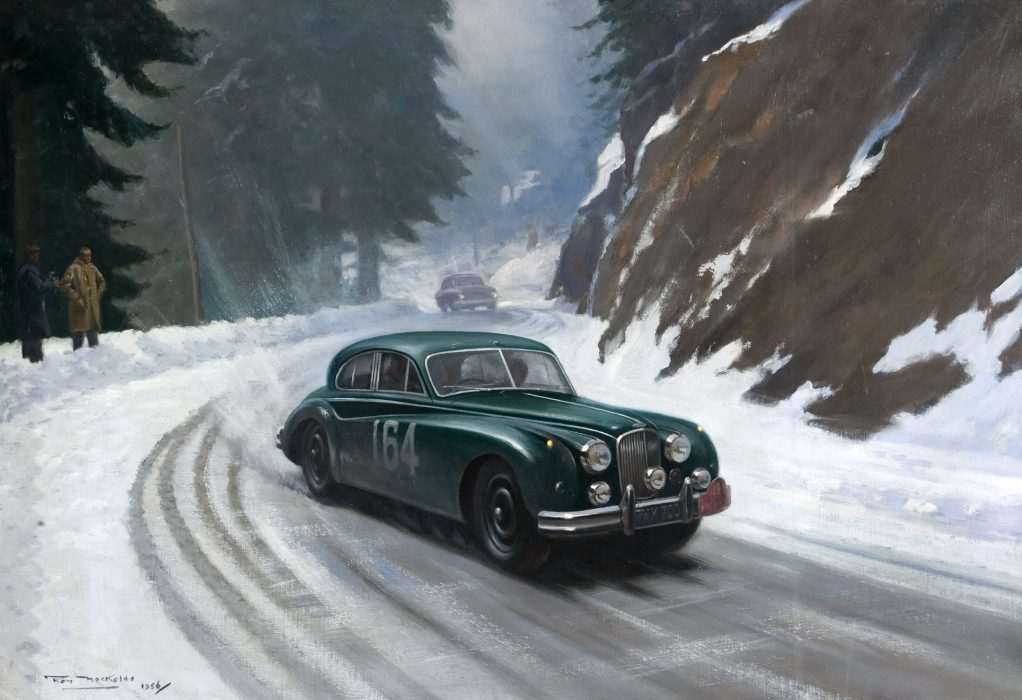
Jaguar Mark VIIM Monte Carlo Rally, Roy Nockolds, 1956
The Artwork
This is one of nine paintings by artist Roy Anthony Nockolds in the Jaguar Daimler Heritage Trust’s Collection, most of which were commissioned by Jaguar Cars. It depicts the Jaguar Mark VIIM which won the Monte Carlo Rally in 1956.
Unlike the Nockolds’ paintings of Jaguar’s wins at Le Mans and Reims, this painting has a distinct change of both location and pace. It shows the 1956 Monte Carlo Rally-winning Jaguar Mark VIIM – driven by Ronnie Adams, Frank Bigger and Derek Johnston – in a typical snowy location. Nockolds’ characteristic use of light and dark is provided by the contrasts between the snow covered road and the dark brown of the trees and mountain slopes. The combination of the snow sprayed up from the rear tyres and the rear of the car stepping out on the mountain bend, gives a real sense of speed and drama to the scene. The figures of the photographer and his companion on the left give scale to the picture.
The painting is currently on public display in the Collections Centre at the British Motor Museum at Gaydon.
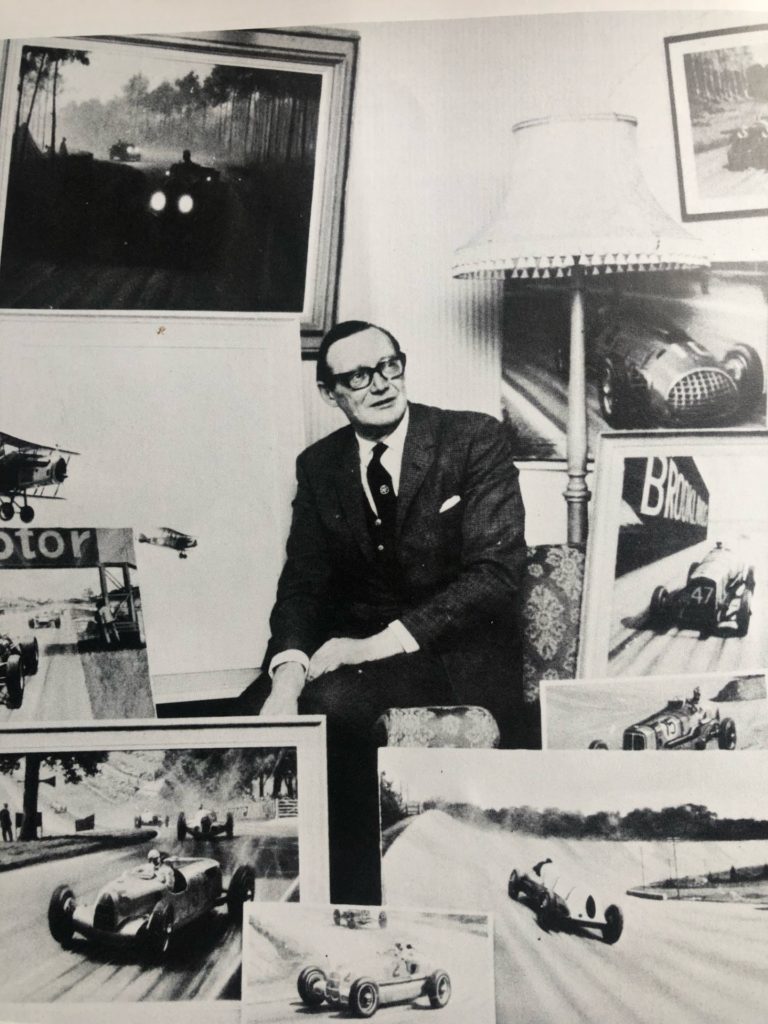
The Artist
Roy Nockolds was born in Croydon in 1911. He always claimed that his only successful subject was art and this was confirmed by two certificates from the Royal Drawing Society in 1922 (age 11) and 1923 (age 12). According to Nockolds’ recollections he first visited Brooklands in 1924 (age 13) where he became impressed by the power and speed of the racing cars and within two years, he was producing motoring art. By the time he was in his teens he was getting his pictures published in the motoring press. His early work was mainly pencil and charcoal drawings, but he also used ink, scraperboard, lino cut and dry point etching as well as watercolours.
F Gordon Crosby was already illustrating for The Autocar and Nockolds was fortunate to have most of his early work published by Motor Sport and Light Car. Although to his credit, Autocar was publishing full page reproductions of some of his etchings in 1932 (age 21). The first recorded exhibition of his work was in December 1934 at the Lombard Restaurant, Cheyne Walk, Chelsea. Around this time he was working as a freelance artist although some of his work was being used by The Motor to illustrate a weekly series of famous corners on racing circuits.
The start of war in 1939 brought a cessation of motor racing for the duration and Nockolds carried on working from his London studio as a general illustrator and for the services, particularly the RAF producing propaganda art.
[Photo courtesy of Nockolds’ daughter Rosanna Hackett]
In 1942 he was asked to look at improving the camouflage of night fighters. He noticed that a white owl was more difficult to see against a night sky than a dark bird. His idea was to paint the leading edge of the wing and underside of the aircraft white and the top of the aircraft black making it difficult to see from above and below. He prepared a painted model of a De Haviland Mosquito aircraft which was transferred to a full sized plane, resulting in the whole of 151 Mosquito Squadron being converted to the new scheme within days. Other camouflage work led to him being called up into the RAF, at the end of 1942 initially as a Clerk, but by 1943 he was posted to the aircraft research station at Farnborough where he had civilian status. He continued the propaganda paintings and his work on camouflage of aircraft, particularly bombers and accepted commissions to supplement his income. The end of the war saw the restart of racing and he resumed his motoring artworks including commissions from car makers such as Ford, Standard, Rover, Rolls-Royce and the Rootes Group and component manufacturers such as Lockheed and Lucas.
It was during this period that he was commissioned by Jaguar and some of the sponsors and suppliers to produce all the paintings that we have in our Artwork Collection. Nockolds’ connection with Jaguar began when the Esso Petroleum Company commissioned him to depict Le Mans 1951 when Peter Walker and Peter Whitehead drove their C-type through pouring rain to give Jaguar their first victory at Le Mans. He then worked closely with Jaguar’s PR Manager Ernest (Bill) Rankin for the next decade undertaking a series of commissions, many of race winning situations but also pictures for calendars, Christmas cards and advertising posters. He was a master of combining light and texture into his work to give the impression of speed and this comes across in several of our paintings.
His work was displayed in many exhibitions in the UK and twenty-four of his paintings were exhibited in New York in 1960 in an exhibition entitled ‘British Motoring Achievements’. This was a collection of paintings depicting outstanding performances of British cars during the previous ten years including some of our race winning Jaguar pictures.
Nockolds took a very keen interest in the Brooklands society founded in 1967, being an early Committee Member and the Chairman from 1976 to 1978, only resigning with the onset of ill health. He was elected Chairman of the Guild of Aviation Artists in 1975, and continued to paint late into his life before passing away in 1979.
Jaguar and Rallying
Jaguar wasn’t only involved in endurance racing with C-types and D-types but had a long history of rallying going back to the days of SS Cars and the Alpine Rallies of the 1930s. Ian and Pat Appleyard (William Lyons’ daughter) famously rallied XK120 registration number NUB 120 to victory in the Alpine Rally in 1950 and 1951 and completed 1952 with no penalty points winning them the Coupe D’Or (Gold Cup).
The Appleyards and other rally drivers then moved on to rallying some of the larger saloon cars – the Mark VII/VIII and in 1956 a total of 16 Jaguars entered for the Monte Carlo Rally, 15 which were Mark VIIs. The 16th was a Mark I compact saloon entered from Rome.
The Mark VIIM car # 164, registered PWK 700 in this painting, was driven by Ronnie Adams, Frank Bigger and Derek Johnston who started from Glasgow, along with 8 other Mark VIIs, won the rally.
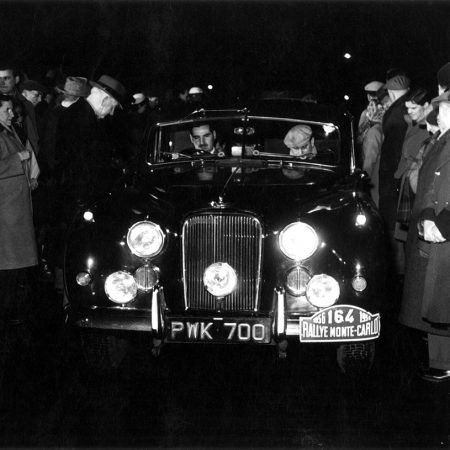
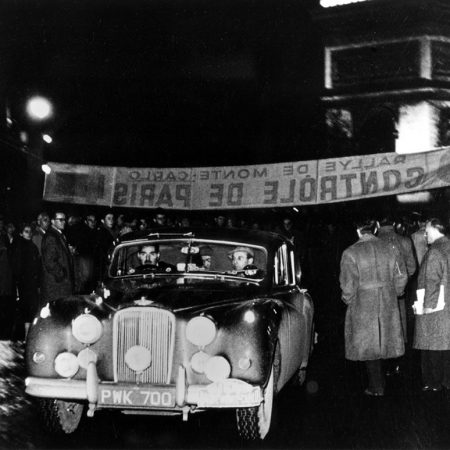
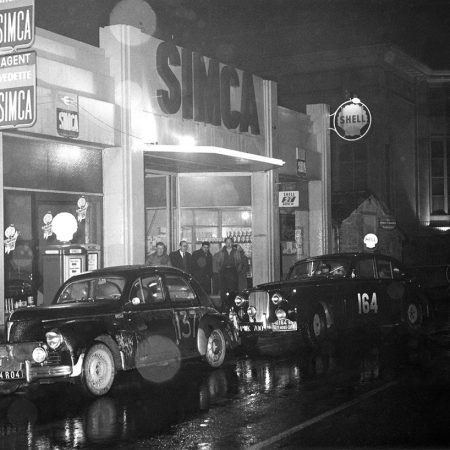
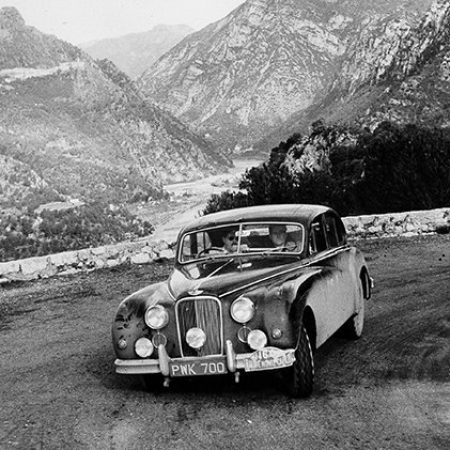
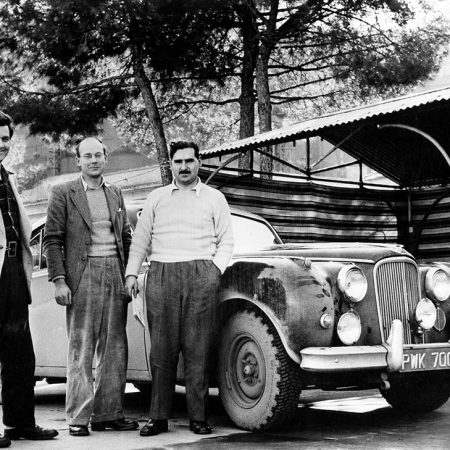
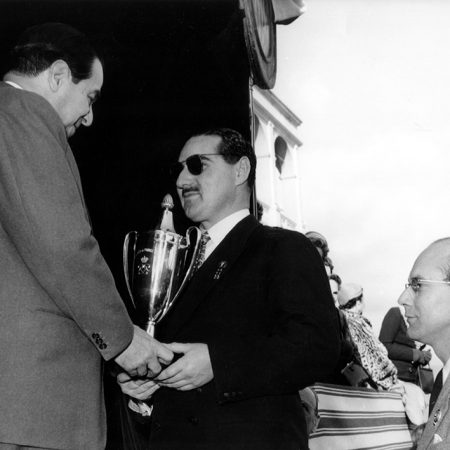
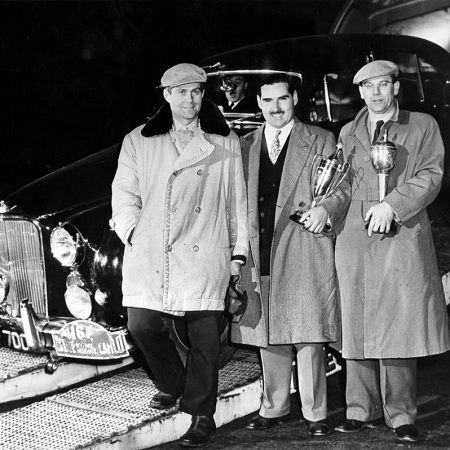
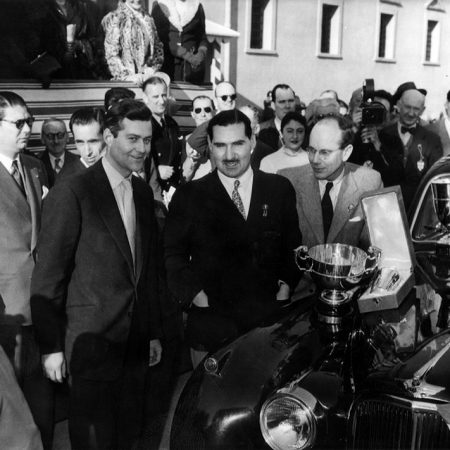
On the face of it, a large Mark VII saloon may seem an odd choice for a rally car, but it had a number of benefits over smaller, more ‘sporty’, cars. There was plenty of room in the car for driver, navigator and passenger and plenty of boot space for luggage and spare parts. There was enough room on the rear seat for drivers to take turns catching some sleep and the navigator had ample space for all his maps, notes and time keeping equipment.
The car was also big, heavy and well built, giving excellent traction in the snow and more than enough power to climb the steepest inclines and maintain a steady speed. The fact that 13 of the 15 Mark VIIs entered for the 1956 Monte Carlo rally finished is testament to their reliability and suitability for such events. Adams, a former winner on the Circuit of Ireland Rally, became the first person from Northern Ireland to win.
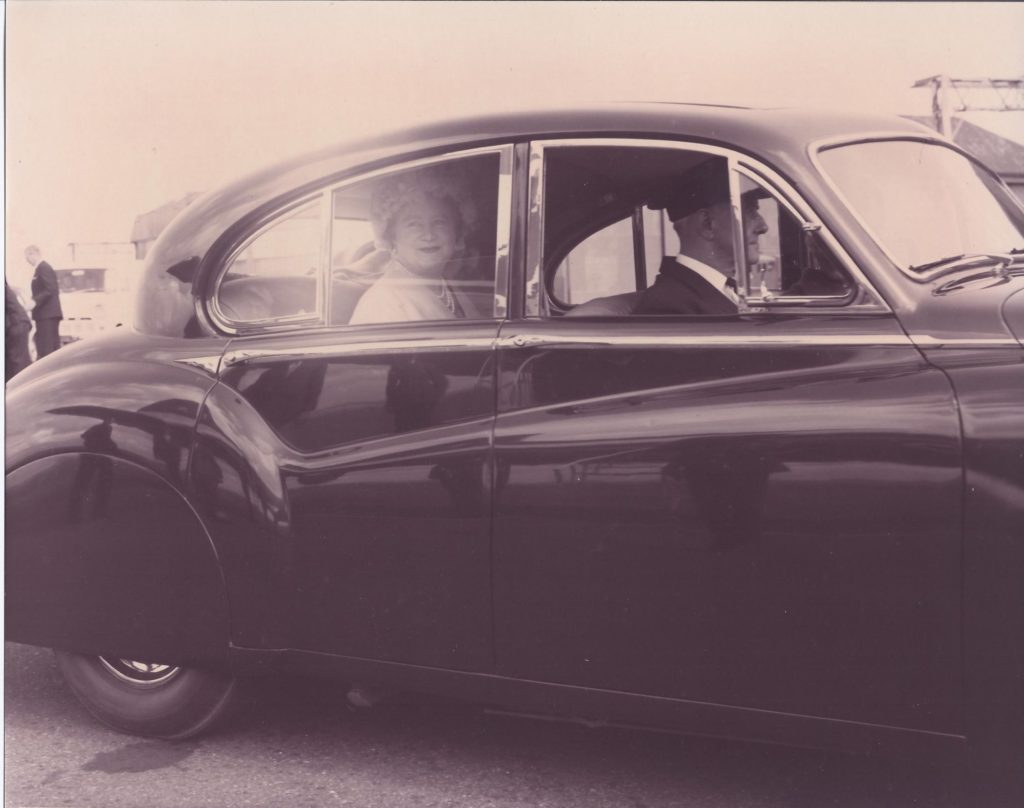
1955 Jaguar Mark VIIM owned by HM Queen Mother
We don’t have PWK 700 in the collection but we do have one Mark VIIM which will help visitors understand the sheer size and scale of these large 1950s saloons.
We have the 1955 Mark VII which was owned by HM The Queen Mother and she kept for about 20 years, registered as NLT 7.
The Queen Mother took delivery of this car in 1955, finished in a special metallic version of Royal Claret. This is an example of the Mark VIIM model which was produced from 1954, but was updated for Her Majesty with features from the later Mark VIII/IX models: such as the one-piece windscreen; improved lighting front and rear, including flashing indicators to replace the original trafficators and all round disc brakes.
She kept the car for her private motoring until 1973 when she replaced it with a 1973 Jaguar XJ12 Vanden Plas Saloon. The Mark VIIM came back to Jaguar and was re-registered as 464 HYV. It was subsequently transferred into the care of the Jaguar Daimler Heritage Trust and is maintained in roadworthy condition and MOTed.
Click the button for more information on 464 HYV: